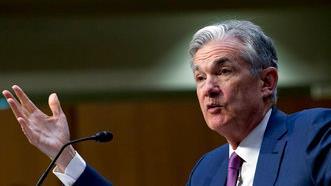Fed expected to raise interest rates again as hiring, wages grow
The Federal Reserve appears ready to hike interest rates Wednesday for the third time this year, as the central bank responds to rising inflation and robust hiring by U.S. employers.
As the Federal Open Market Committee begins a two-day meeting Tuesday, investors widely expect policymakers to set in motion another increase to short-term interest rates. Investors and economists will also be watching Fed Chairman Jerome Powell, whose comments during a Wednesday afternoon press conference, may offer a better picture of officials’ plans heading into 2019 and potential concerns over the economic impact of new import tariffs.
The Fed has been rolling back policies aimed at stimulating the U.S. economy in the aftermath of the 2008 financial crisis. Officials have raised rates seven times since 2015, and forecasts penciled in two more rate hikes during meetings this week and in December. The central bank also has begun the process of winding down its balance sheet after accumulating large amounts of government bonds and mortgage-backed securities.
Fed officials have gradually raised rates to prevent the economy from overheating, or growing too fast and causing prices to spike. Policymakers have telegraphed a total of four rate hikes in 2018, followed by three increases in 2019.
Fed watchers believe U.S. economic conditions will allow policymakers to stay on track. The Federal Reserve Bank of Atlanta’s GDPNow forecast is calling for economic growth of 4.4 percent in the third quarter, which would mark the second consecutive quarter of gains over 4 percent. In August, unemployment remained near its lowest rate since 2000, and wages posted their largest annual gain since 2009. With employment levels strong and inflation meeting the Fed’s internal target, some of the more dovish FOMC members have recently sent hawkish signals on interest rates.
Bill Northey, senior vice president at U.S. Bank Wealth Management, said trade tensions and other geopolitical concerns have yet to encroach on the central bank’s dual mandate of supporting maximum employment and stable prices.
“As we look at market views, we can see the market hasn’t quite priced in the Fed’s full communicated path. Without any material adverse shock, we expect that path to come to fruition,” he said, noting that inflation measures and hourly wages are at cycle highs.
Investors have put nearly 94 percent odds on the Fed raising its benchmark short-term rate to a range of 2 percent to 2.25 percent this week, according to the CME’s FedWatch Tool. A fourth increase in December is also seen as likely, with odds of 74.1 percent.
“Something pretty significant would have to happen for the Fed not to hike in December,” said Tom Essaye, founder and editor of The Sevens Report.
The market is somewhat less certain about the pace of rate hikes in 2019. In addition to uncertainty tied to global trade deals, investors may have concerns that the yield curve has come close to inversion, a bearish sign that emerges when rates on long-term debt slip below short-term rates. As for inflation, prices were slow to rise in spite of economic growth and falling unemployment.
But inflation has caught up in recent months. The core personal consumption expenditures (PCE) index – the Fed’s preferred measure of inflation – has now hit the central bank’s target three times this year. In July, the index rose 2 percent.
The Fed’s economic forecast and “dot plot,” which shows policymakers’ expectations for interest rates over the coming years, will offer more clues on the path forward for rate hikes. The Fed’s use of “accommodative” in describing monetary policy is also key. While a faster run-up in inflation could foreshadow additional rate hikes, removing the word “accommodative” from its post-meeting statement would be considered a sign that the Fed will raise rates no more than three times next year, Essaye explained.
“There’s a 50-50 chance they remove that word, which is a big deal,” Essaye said. “For 2019, removing that word would be a dovish event. It means we are closer to the end of this rate-hike cycle than we thought.”
The FOMC will issue a statement at 2 p.m. ET on Wednesday. Powell is scheduled to address the media at 2:30 p.m. ET.




















